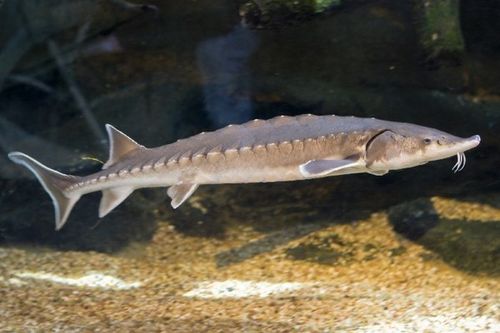The scientific name of Acipenser schrencki is Acipenser schrencki, and its foreign name is Amur Sturgeon. It has the characteristics of large size, long lifespan, high survival rate of young fish, and fast growth rate. It is both ornamental and delicious.

Acipenser schrenckii is an animal-eating fish. Its digestive system contains both the pyloric caeca of bony fish and the valvular intestine of cartilaginous fish, so it has a high hydration absorption function. Adult fish feed on aquatic insects and aquatic insect larvae, mollusks, benthic crustaceans, and lamprey larvae, and sometimes small fish. The food of young fish is mainly zooplankton, benthic animals, and aquatic insect larvae. During the dissection, it was also found that there were sometimes aquatic plant debris in the stomach. Therefore, when there is less animal food, Acipenser schrenckii occasionally eats aquatic plants.
Acipenser schrenckii feeds slowly and mainly relies on touch and smell to hunt. Adult fish have strong feeding ability and stop feeding during the breeding period of broodstock. The water temperature for Acipenser schrenckii to open and feed is 4℃, and the feeding ability is enhanced when it exceeds 13℃. The best water temperature for feeding is 18-22℃. Acipenser schrenckii that has been domesticated can eat artificial compound feed, and the protein content of the feed is between 37% and 52%.
Acipenser schrenckii matures late in Heilongjiang waters. The first sexual maturity age of females is 9-13 years old, and that of males is 6-7 years old. The reproductive cycle of Acipenser schrenckii is long, generally between 2-4 years. The fish are 108-116 cm long and weigh 6-8 kg. They mature at 10-14 years old.
The breeding population of Acipenser schrenckii in Heilongjiang River is divided into spring migratory and autumn migratory types. The breeding population of Acipenser schrenckii in Heilongjiang River in spring from May to June swims to the spawning grounds for breeding in the same year. The autumn migratory type swims to the spawning grounds from August to September every year, moves around the spawning grounds, and waits until the spring of the following year to spawn and breed. The suitable water temperature for breeding is 17-20℃. Acipenser schrenckii lays sticky eggs in the river section with steady water flow and gravel bottom of 2-3 meters deep. The sex ratio of male and female fish is about 1:1.67. The female Acipenser schrenckii generally carries 30,000 to 1.6 million eggs, up to 2.8 million eggs, with an egg diameter of 2.5-3.5 mm. The average number of mature eggs per gram is 44. The mature eggs are oval, gray-green or black-green, shiny and elastic. The weight of eggs carried by Acipenser schrenckii accounts for 10%-42% of its body weight, with an average of about 25%.
The fertilization rate of Acipenser schrenckii in natural conditions is low. The accumulated temperature of fertilized sturgeon eggs reaches 1800-1980 degrees at a water temperature of 17-21℃. The fry hatch out of the membrane. The newly hatched fry cannot swim in balance due to the large egg sac, and swim intermittently in the water. As early as 1987, the Heilongjiang Provincial Specialty Fish Research Institute succeeded in artificial propagation of Acipenser schrenckii, and in the following years, it explored and summarized a set of comprehensive technical experience in seed cultivation and artificial breeding of Acipenser schrenckii, and promoted artificial breeding of Acipenser schrenckii to many places across the country.
There are two types of Acipenser schrenckii in the Heilongjiang area: brown and gray. The brown type grows slower than the gray type. The 12-year-old female individual is 96-117 cm long and weighs 3.5-5.6 kg. It mainly grows in the middle and lower reaches of the Heilongjiang River, with low resource and yield; the 12-year-old female individual of the gray type is 125-142 cm long and weighs 8.3-16.4 kg. It mostly lives in brackish waters at the mouth of the stream and feeds on benthic organisms. In the spawning group of the gray species, 80% of the individuals have gonads in stage IV during the wintering period, and they begin to spawn and migrate in autumn. Some individuals that have not reached sexual maturity also migrate from the mouth of the river to the Heilongjiang River channel, and then descend to the estuary area after maturing and spawning.
Due to overfishing, its resources have been sharply reduced.
Listed in the 2010 Red List of Endangered Species of the World Conservation Union (IUCN) ver 3.1 - Critically Endangered (CR).
Listed in Appendix II of the Washington Convention on International Trade in Endangered Species (CITES).
Listed in the second level of the "List of National Key Protected Wildlife in China". (Wild populations only)
Protect wild animals and eliminate game.
Maintaining ecological balance is everyone's responsibility!